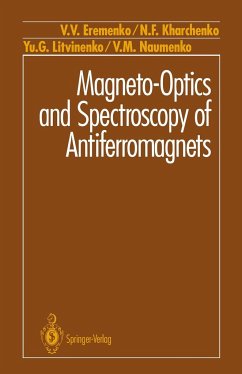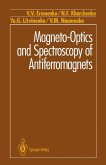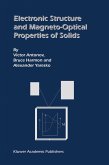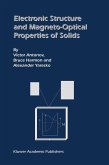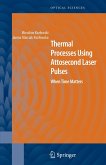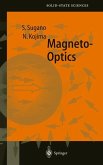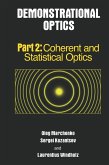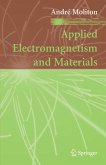V. V. Eremenko, N. F. Kharchenko, Yu.G. Litvinenko, V. M. Naumenko
Magneto-Optics and Spectroscopy of Antiferromagnets
V. V. Eremenko, N. F. Kharchenko, Yu.G. Litvinenko, V. M. Naumenko
Magneto-Optics and Spectroscopy of Antiferromagnets
- Gebundenes Buch
- Merkliste
- Auf die Merkliste
- Bewerten Bewerten
- Teilen
- Produkt teilen
- Produkterinnerung
- Produkterinnerung
Certain magnetic materials have optical properties that make them attractive for a wide variety of applications such as optical switches. This book describes the physics of one class of such magnetooptic materials, the insulating antiferromagnets. The authors summarize recent results concerning the structure, optical properties, spectroscopy, and magnetooptical properties of these materials. In particular, they consider magnetic phase transitions, symmetry effects, the linear magnetooptical effect, magnons, spectroscopic study of spin waves, photoinduced magnetic effects, and the effects of impurities.…mehr
Andere Kunden interessierten sich auch für
![Magneto-Optics and Spectroscopy of Antiferromagnets Magneto-Optics and Spectroscopy of Antiferromagnets]() V. V. EremenkoMagneto-Optics and Spectroscopy of Antiferromagnets42,99 €
V. V. EremenkoMagneto-Optics and Spectroscopy of Antiferromagnets42,99 €![Electronic Structure and Magneto-Optical Properties of Solids Electronic Structure and Magneto-Optical Properties of Solids]() Victor AntonovElectronic Structure and Magneto-Optical Properties of Solids280,99 €
Victor AntonovElectronic Structure and Magneto-Optical Properties of Solids280,99 €![Electronic Structure and Magneto-Optical Properties of Solids Electronic Structure and Magneto-Optical Properties of Solids]() Victor AntonovElectronic Structure and Magneto-Optical Properties of Solids137,99 €
Victor AntonovElectronic Structure and Magneto-Optical Properties of Solids137,99 €![Thermal Processes Using Attosecond Laser Pulses Thermal Processes Using Attosecond Laser Pulses]() Miroslaw KozlowskiThermal Processes Using Attosecond Laser Pulses123,99 €
Miroslaw KozlowskiThermal Processes Using Attosecond Laser Pulses123,99 €![Magneto-Optics Magneto-Optics]() Satoru Sugano / Norimichi Kojima (eds.)Magneto-Optics125,99 €
Satoru Sugano / Norimichi Kojima (eds.)Magneto-Optics125,99 €![Demonstrational Optics Demonstrational Optics]() Oleg MarchenkoDemonstrational Optics62,99 €
Oleg MarchenkoDemonstrational Optics62,99 €![Applied Electromagnetism and Materials Applied Electromagnetism and Materials]() André MolitonApplied Electromagnetism and Materials63,99 €
André MolitonApplied Electromagnetism and Materials63,99 €-
-
-
Certain magnetic materials have optical properties that make them attractive for a wide variety of applications such as optical switches. This book describes the physics of one class of such magnetooptic materials, the insulating antiferromagnets. The authors summarize recent results concerning the structure, optical properties, spectroscopy, and magnetooptical properties of these materials. In particular, they consider magnetic phase transitions, symmetry effects, the linear magnetooptical effect, magnons, spectroscopic study of spin waves, photoinduced magnetic effects, and the effects of impurities.
Hinweis: Dieser Artikel kann nur an eine deutsche Lieferadresse ausgeliefert werden.
Hinweis: Dieser Artikel kann nur an eine deutsche Lieferadresse ausgeliefert werden.
Produktdetails
- Produktdetails
- Verlag: Springer, Berlin
- 1992.
- Seitenzahl: 276
- Erscheinungstermin: 23. September 1992
- Englisch
- Abmessung: 241mm x 162mm x 18mm
- Gewicht: 580g
- ISBN-13: 9780387977010
- ISBN-10: 0387977015
- Artikelnr.: 24483210
- Herstellerkennzeichnung
- Libri GmbH
- Europaallee 1
- 36244 Bad Hersfeld
- gpsr@libri.de
- Verlag: Springer, Berlin
- 1992.
- Seitenzahl: 276
- Erscheinungstermin: 23. September 1992
- Englisch
- Abmessung: 241mm x 162mm x 18mm
- Gewicht: 580g
- ISBN-13: 9780387977010
- ISBN-10: 0387977015
- Artikelnr.: 24483210
- Herstellerkennzeichnung
- Libri GmbH
- Europaallee 1
- 36244 Bad Hersfeld
- gpsr@libri.de
1 Magneto-Optic Effects in Non-Centroantisymmetrical Antiferromagnetic Crystals.- 1.1. Symmetry of the Optical Properties of Magnetically Ordered Crystals.- 1.2. Symmetry of the Linear Magneto-Optic Effect (LMOE).- 1.3. Light Polarization Transformation at Magneto-Optic Effects, and Specific Features of Experimental Method.- 1.4. Experimental Investigations of the Linear Magneto-Optic Effect.- 1.4.1. The Linear Magneto-Optic Effect in Cobalt Carbonate.- 1.4.2. Reduction of the Optical Class of Tetragonal Antiferromagnetic Cobalt Fluoride in a Longitudinal Magnetic Field.- 1.4.3. Orthorhombic Noncollinear (Canted) Antiferromagnetic DyFeO3.- 1.4.4. The Linear Magneto-Optic Effect in Other Antiferromagnetic Crystals.- 1.5. Magnetic Gyrotropy Quadratically Dependent on Magnetic Field Strength.- 2 Magneto-Optical Methods for Investigating the Structure of Antiferromagnetically Ordered Crystals.- 2.1. Visualization of Collinear or 180-Degree Antiferromagnetic Domains.- 2.1.1. Antiferromagnetic Domains in a Tetragonal Cobalt Fluoride.- 2.1.2. The Magnetic Phase Transition in Cobalt Fluoride Induced by a Magnetic Field H ? C4.- 2.2. Magnetic Structure of the Antiferromagnetic Calcium Manganese Germanium (CaMnGe) Garnet.- 2.2.1. The Magnetic Point Symmetry of Manganese Germanium Garnet.- 2.2.2. Magneto-Optical Observation of Crystalline Twins.- 2.3. The Antiferromagnetic Domains and Two-Phase Magnetic Structures in DyFeO3.- 2.3.1. Antiferromagnetic Domains.- 2.3.2. The Incoherent Two-Phase Domain Structure.- 2.3.3. Coherent Two-Phase Domain Structures.- 3 Optical Magnetic Excitations.- 3.1. The Exciton Description of Magnetic Excitations.- 3.2. The Mechanism of Magnetic Excitation Generation by Light.- 3.2.1. One-Particle Processes (Magnetic Dipole Absorption and Emission).- 3.2.2. Multiparticle Processes (Electric Dipole Absorption and Emission).- 3.2.3. Bonded States.- 3.2.4. Parametric Excitation by Optical Pumping.- 3.2.5. An Estimate of Some Parameters of Optical Excitations.- 3.3. Multiquantum Excitation of Two-Particle Transitions.- 3.3.1. Multiquantum Absorption of Light.- 3.3.2. Two-Exciton Absorption of Light in the Case of Four-Quantum Excitation.- 3.3.3. Influence of Statistical Properties of Light on Two-Exciton Four-Photon Absorption.- 3.4. Dynamics of Magnetic Excitons.- 3.4.1. Transfer of Electron Excitation Energy.- 3.4.2. Character of Exciton Motion.- 3.4.3. Coherent Excitons.- 3.4.4. Noncoherent Magnetic Excitons.- 3.4.5. Change of Exciton Mobility at Inducing Intersublattice Transitions.- 3.5. Radiation Decay of Magnetic Excitons.- 3.5.1. The Increase of Exciton Magnon Luminescence in a Magnetic Field.- 3.5.2. Enhancement of Exciton Radiation Transition.- 3.5.3. Biexciton Annihilation.- 4 Magnetic Excitons as a Method of Study of the Magnetic Properties of Antiferromagnets.- 4.1. Spectroscopic Studies of Spin Waves.- 4.1.1. Three-Dimensional Magnetic Crystals. Energy of Magnons at the Boundary of the Brillouin Zone.- 4.1.2. Low-Dimensional Magnetic Crystals. Magnon Energies Inside the Brillouin Zone.- 4.1.3. Impurity Modes.- 4.2. Magnetic Excitons as an Instrument to Investigate the Magnetic Configurations of Antiferromagnets.- 4.2.1. Equilibrium Structures.- 4.2.2. Phase Transitions in an Antiferromagnet with Anisotropy of Easy-Axis Type.- 4.3. Photoinduced Magnetic Effects.- 4.3.1. ErCrO3. Spin-Reorientation Phase Transitions.- 4.3.2. EuCrO3. Origin of a New Magnetically Ordered Phase.- 4.3.3. MnF2. Photoinduced Single-Ion Magnetic Anisotropy.- 5 Delocalization of Impurity Excitations in Antiferromagnetic Insulators.- 5.1. Localized States (Single-Impurity Approximation).- 5.1.1. Theory.- 5.1.2. Experimental Data and Their Interpretation.- 5.2. Localization and Delocalization States in the Anderson and Lifshitz Models.- 5.2.1. The Anderson Model.- 5.2.2. The Lifshitz Model.- 5.3. Coherent and Incoherent Impurity Excitations. Impuritons.- 5.3.1. Electron Excitations in the Presence of Large-Radius Impurity States.
1 Magneto-Optic Effects in Non-Centroantisymmetrical Antiferromagnetic Crystals.- 1.1. Symmetry of the Optical Properties of Magnetically Ordered Crystals.- 1.2. Symmetry of the Linear Magneto-Optic Effect (LMOE).- 1.3. Light Polarization Transformation at Magneto-Optic Effects, and Specific Features of Experimental Method.- 1.4. Experimental Investigations of the Linear Magneto-Optic Effect.- 1.4.1. The Linear Magneto-Optic Effect in Cobalt Carbonate.- 1.4.2. Reduction of the Optical Class of Tetragonal Antiferromagnetic Cobalt Fluoride in a Longitudinal Magnetic Field.- 1.4.3. Orthorhombic Noncollinear (Canted) Antiferromagnetic DyFeO3.- 1.4.4. The Linear Magneto-Optic Effect in Other Antiferromagnetic Crystals.- 1.5. Magnetic Gyrotropy Quadratically Dependent on Magnetic Field Strength.- 2 Magneto-Optical Methods for Investigating the Structure of Antiferromagnetically Ordered Crystals.- 2.1. Visualization of Collinear or 180-Degree Antiferromagnetic Domains.- 2.1.1. Antiferromagnetic Domains in a Tetragonal Cobalt Fluoride.- 2.1.2. The Magnetic Phase Transition in Cobalt Fluoride Induced by a Magnetic Field H ? C4.- 2.2. Magnetic Structure of the Antiferromagnetic Calcium Manganese Germanium (CaMnGe) Garnet.- 2.2.1. The Magnetic Point Symmetry of Manganese Germanium Garnet.- 2.2.2. Magneto-Optical Observation of Crystalline Twins.- 2.3. The Antiferromagnetic Domains and Two-Phase Magnetic Structures in DyFeO3.- 2.3.1. Antiferromagnetic Domains.- 2.3.2. The Incoherent Two-Phase Domain Structure.- 2.3.3. Coherent Two-Phase Domain Structures.- 3 Optical Magnetic Excitations.- 3.1. The Exciton Description of Magnetic Excitations.- 3.2. The Mechanism of Magnetic Excitation Generation by Light.- 3.2.1. One-Particle Processes (Magnetic Dipole Absorption and Emission).- 3.2.2. Multiparticle Processes (Electric Dipole Absorption and Emission).- 3.2.3. Bonded States.- 3.2.4. Parametric Excitation by Optical Pumping.- 3.2.5. An Estimate of Some Parameters of Optical Excitations.- 3.3. Multiquantum Excitation of Two-Particle Transitions.- 3.3.1. Multiquantum Absorption of Light.- 3.3.2. Two-Exciton Absorption of Light in the Case of Four-Quantum Excitation.- 3.3.3. Influence of Statistical Properties of Light on Two-Exciton Four-Photon Absorption.- 3.4. Dynamics of Magnetic Excitons.- 3.4.1. Transfer of Electron Excitation Energy.- 3.4.2. Character of Exciton Motion.- 3.4.3. Coherent Excitons.- 3.4.4. Noncoherent Magnetic Excitons.- 3.4.5. Change of Exciton Mobility at Inducing Intersublattice Transitions.- 3.5. Radiation Decay of Magnetic Excitons.- 3.5.1. The Increase of Exciton Magnon Luminescence in a Magnetic Field.- 3.5.2. Enhancement of Exciton Radiation Transition.- 3.5.3. Biexciton Annihilation.- 4 Magnetic Excitons as a Method of Study of the Magnetic Properties of Antiferromagnets.- 4.1. Spectroscopic Studies of Spin Waves.- 4.1.1. Three-Dimensional Magnetic Crystals. Energy of Magnons at the Boundary of the Brillouin Zone.- 4.1.2. Low-Dimensional Magnetic Crystals. Magnon Energies Inside the Brillouin Zone.- 4.1.3. Impurity Modes.- 4.2. Magnetic Excitons as an Instrument to Investigate the Magnetic Configurations of Antiferromagnets.- 4.2.1. Equilibrium Structures.- 4.2.2. Phase Transitions in an Antiferromagnet with Anisotropy of Easy-Axis Type.- 4.3. Photoinduced Magnetic Effects.- 4.3.1. ErCrO3. Spin-Reorientation Phase Transitions.- 4.3.2. EuCrO3. Origin of a New Magnetically Ordered Phase.- 4.3.3. MnF2. Photoinduced Single-Ion Magnetic Anisotropy.- 5 Delocalization of Impurity Excitations in Antiferromagnetic Insulators.- 5.1. Localized States (Single-Impurity Approximation).- 5.1.1. Theory.- 5.1.2. Experimental Data and Their Interpretation.- 5.2. Localization and Delocalization States in the Anderson and Lifshitz Models.- 5.2.1. The Anderson Model.- 5.2.2. The Lifshitz Model.- 5.3. Coherent and Incoherent Impurity Excitations. Impuritons.- 5.3.1. Electron Excitations in the Presence of Large-Radius Impurity States.

